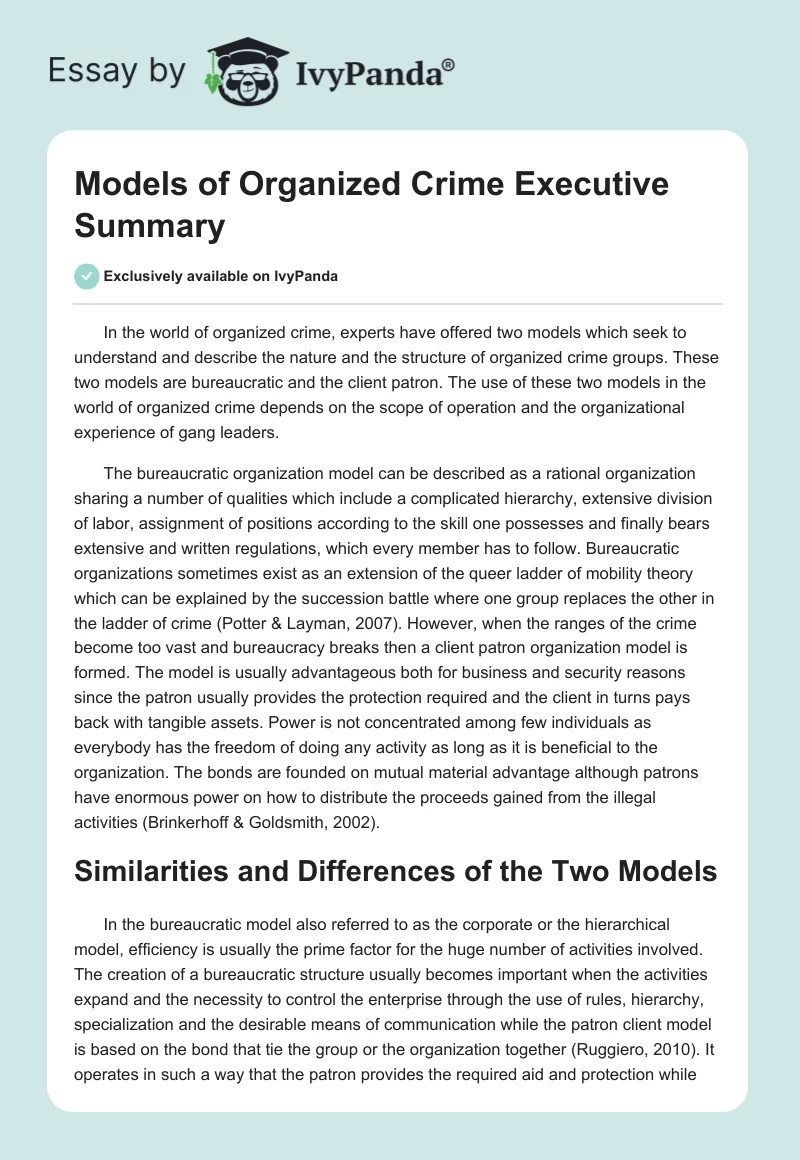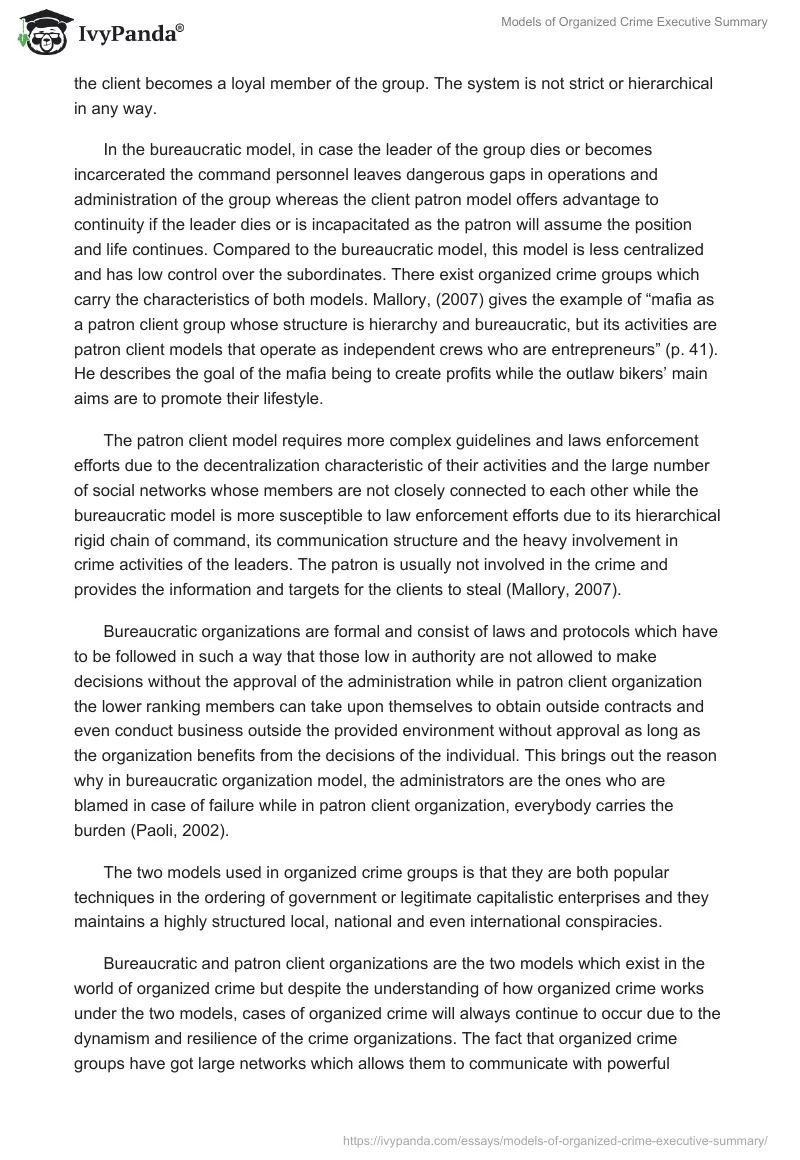In the world of organized crime, experts have offered two models which seek to understand and describe the nature and the structure of organized crime groups. These two models are bureaucratic and the client patron. The use of these two models in the world of organized crime depends on the scope of operation and the organizational experience of gang leaders.
The bureaucratic organization model can be described as a rational organization sharing a number of qualities which include a complicated hierarchy, extensive division of labor, assignment of positions according to the skill one possesses and finally bears extensive and written regulations, which every member has to follow. Bureaucratic organizations sometimes exist as an extension of the queer ladder of mobility theory which can be explained by the succession battle where one group replaces the other in the ladder of crime (Potter & Layman, 2007). However, when the ranges of the crime become too vast and bureaucracy breaks then a client patron organization model is formed. The model is usually advantageous both for business and security reasons since the patron usually provides the protection required and the client in turns pays back with tangible assets. Power is not concentrated among few individuals as everybody has the freedom of doing any activity as long as it is beneficial to the organization. The bonds are founded on mutual material advantage although patrons have enormous power on how to distribute the proceeds gained from the illegal activities (Brinkerhoff & Goldsmith, 2002).
Similarities and Differences of the Two Models
In the bureaucratic model also referred to as the corporate or the hierarchical model, efficiency is usually the prime factor for the huge number of activities involved. The creation of a bureaucratic structure usually becomes important when the activities expand and the necessity to control the enterprise through the use of rules, hierarchy, specialization and the desirable means of communication while the patron client model is based on the bond that tie the group or the organization together (Ruggiero, 2010). It operates in such a way that the patron provides the required aid and protection while the client becomes a loyal member of the group. The system is not strict or hierarchical in any way.
In the bureaucratic model, in case the leader of the group dies or becomes incarcerated the command personnel leaves dangerous gaps in operations and administration of the group whereas the client patron model offers advantage to continuity if the leader dies or is incapacitated as the patron will assume the position and life continues. Compared to the bureaucratic model, this model is less centralized and has low control over the subordinates. There exist organized crime groups which carry the characteristics of both models. Mallory, (2007) gives the example of “mafia as a patron client group whose structure is hierarchy and bureaucratic, but its activities are patron client models that operate as independent crews who are entrepreneurs” (p. 41). He describes the goal of the mafia being to create profits while the outlaw bikers’ main aims are to promote their lifestyle.
The patron client model requires more complex guidelines and laws enforcement efforts due to the decentralization characteristic of their activities and the large number of social networks whose members are not closely connected to each other while the bureaucratic model is more susceptible to law enforcement efforts due to its hierarchical rigid chain of command, its communication structure and the heavy involvement in crime activities of the leaders. The patron is usually not involved in the crime and provides the information and targets for the clients to steal (Mallory, 2007).
Bureaucratic organizations are formal and consist of laws and protocols which have to be followed in such a way that those low in authority are not allowed to make decisions without the approval of the administration while in patron client organization the lower ranking members can take upon themselves to obtain outside contracts and even conduct business outside the provided environment without approval as long as the organization benefits from the decisions of the individual. This brings out the reason why in bureaucratic organization model, the administrators are the ones who are blamed in case of failure while in patron client organization, everybody carries the burden (Paoli, 2002).
The two models used in organized crime groups is that they are both popular techniques in the ordering of government or legitimate capitalistic enterprises and they maintains a highly structured local, national and even international conspiracies.
Bureaucratic and patron client organizations are the two models which exist in the world of organized crime but despite the understanding of how organized crime works under the two models, cases of organized crime will always continue to occur due to the dynamism and resilience of the crime organizations. The fact that organized crime groups have got large networks which allows them to communicate with powerful economic, administration and political structures shows why organized crime will remain part of our culture for a very long period. Finally with advancements in technology, new era of globalization and efficient communication methods, their connections to multinational organizations will make it even harder to control it.
Reference List
Brinkerhoff D.W; Goldsmith A.A. (2002). Clientelism, Patrimonialism and Democratic Governance: An Overview and Framework for Assessment and Programming. Web.
Mallory, S.L. (2007). Understanding Organized Crime. New York: Jones & Bartlett Learning
Paoli, L. (2002). The paradoxes of organized crime. New York: Kluwer Academic Publishers.
Potter, W. G; Lyman D. M. (2007). Organize Crime, 4th edition. New York: Prentice Hall
Ruggiero, V. (2010). Organized Crime: Between the Informal and the Formal Economy, Working Papers Series, no. 4, July, Global Consortium on Security Transformation. Web.


